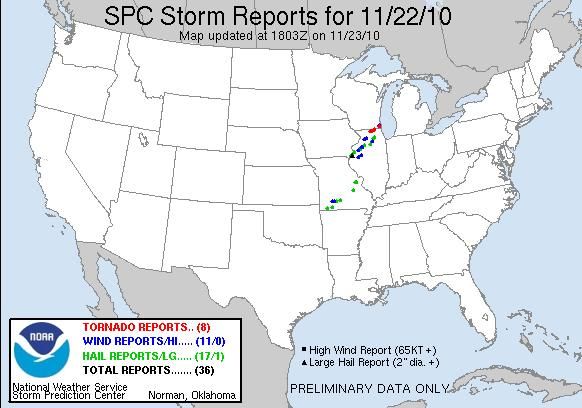
Rare Storms: November Tornadoes Hit Midwest

November's wild and weird weather finally arrived yesterday, as rare tornadoes hit parts of the Midwest.
The month of November is known as the second tornado season of the year, but it has been a snooze this year until lately, with only three reported tornadoes as of Nov. 19.
The main tornado season runs from spring to early summer, but tornadoes can form under a variety of conditions and strike during fall and winter. (As one example, a weak tornado hit Brooklyn and Queens in September.)
In all, eight tornadoes were reported to have formed yesterday, according to the U.S. National Oceanic and Atmospheric Administration's (NOAA) Storm Prediction Center in Norman, Okla. No fatalities were reported.
Midwest tornadoes
After a long November tornado lull, a twister hit Caledonia, Ill. the first November tornado to hit Illinois in more than five years. The tornado flipped a school bus and injured the driver and several children.
Since 1990, there have been just six other November tornado events in the state of Illinois, according to The Weather Channel's website.
Sign up for the Live Science daily newsletter now
Get the world’s most fascinating discoveries delivered straight to your inbox.
In Wisconsin, the first November tornado in more than 39 years which boasted an EF1 strength rating struck Walworth County. Another was reported in Union Grove, Wis., but has not been confirmed. Only three November tornadoes have hit Wisconsin since 1950 before Monday (two on Nov. 15, 1960, and one on Nov. 1, 1971). [Related: What Day Had The Most Tornado Strikes?]
"The tornadoes will be confirmed when damage surveys are completed by the local National Weather Service Forecast Office," said Susan Cobb, a meteorologist with NOAA's National Severe Storms Laboratory, in an e-mail.
This often takes several months as scientists literally trace a twister's path of destruction.
"They have to go look at the damage and see if it's a contiguous track or not," said Robert Henson, meteorologist with the National Center for Atmospheric Research in Boulder, Colo.
November twisters
Fall and spring are both transitional periods when masses of warm and cool air are more likely to collide and create the thunderstorms that can spawn tornadoes.
Tornadoes form where warm moist air is trapped underneath a layer of cold, dry air. The strongest tornadoes often form when the wind at around 10,000 feet (3,000 meters) above the ground blows in a different direction than the surface wind. In the spring, warm air rising in the storm system hits this so-called wind shear and is pushed from a vertical motion to a horizontal motion, creating a strong rotation.
In the fall, wind shear returns across the United States as the jet stream a fast but narrow air current moves back south after a summer spent up north. Warm, moist air is still at the surface.
The big difference between the spring and fall tornado seasons is that the temperatures in that top layer are typically a little warmer for a given surface temperature in the fall than in the spring. As a result, the atmosphere does not have as much potential energy and therefore fewer storms strike during the fall.
November tornadoes tend to be more common in the lower Mississippi valley, including states such as Louisiana, Arkansas and Mississippi. This is because moist air from the Gulf Coast can more easily reach these states, while it may be blocked from spreading elsewhere, Henson told OurAmazingPlanet.
- The World's Weirdest Weather
- In Images: Storm Chasing Scientists
- Skyscraper Storms: 7 Big City Tornadoes
Reach OurAmazingPlanet staff writer Brett Israel at bisrael@techmedianetwork.com. Follow him on Twitter @btisrael.












